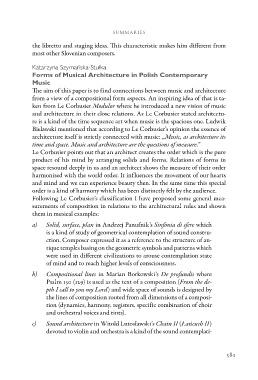Page 383 - Vinkler, Jonatan, in Jernej Weiss. ur. 2014. Musica et Artes: ob osemdesetletnici Primoža Kureta. Koper: Založba Univerze na Primorskem.
P. 383
summaries
the libretto and staging ideas. This characteristic makes him different from
most other Slovenian composers.
Katarzyna Szymańska-Stułka
Forms of Musical Architecture in Polish Contemporary
Music
The aim of this paper is to find connections between music and architecture
from a view of a compositional form aspects. An inspiring idea of that is ta-
ken from Le Corbusier Modulor where he introduced a new vision of music
and architecture in their close relations. As Le Corbusier stated architectu-
re is a kind of the time sequence art when music is the spacious one. Ludwik
Bielawski mentioned that according to Le Corbusier’s opinion the essence of
architecture itself is strictly connected with music: „Music, as architecture its
time and space. Music and architecture are the questions of measure.”
Le Corbusier points out that an architect creates the order which is the pure
product of his mind by arranging solids and forms. Relations of forms in
space resound deeply in us and an architect shows the measure of their order
harmonised with the world order. It influences the movement of our hearts
and mind and we can experience beauty then. In the same time this special
order is a kind of harmony which has been distinctly felt by the audience.
Following Le Corbusier’s classification I have proposed some general mea-
surements of composition in relations to the architectural rules and shown
them in musical examples:
a) Solid, surface, plan in Andrzej Panufnik’s Sinfonia di sfere which
is a kind of study of geometrical contemplation of sound constru-
ction. Composer expressed it as a reference to the structure of an-
tique temples basing on the geometric symbols and patterns which
were used in different civilizations to arouse contemplation state
of mind and to reach higher levels of consciousness.
b) Compositional lines in Marian Borkowski’s De profundis where
Psalm 130 (129) is used as the text of a composition (From the de-
pth I call to you my Lord) and wide space of sounds is designed by
the lines of composition routed from all dimensions of a composi-
tion (dynamics, harmony, registers, specific combination of choir
and orchestral voices and tints).
c) Sound architecture in Witold Lutosławski’s Chain II (Łańcuch II)
devoted to violin and orchestra is a kind of the sound contemplati-
381
the libretto and staging ideas. This characteristic makes him different from
most other Slovenian composers.
Katarzyna Szymańska-Stułka
Forms of Musical Architecture in Polish Contemporary
Music
The aim of this paper is to find connections between music and architecture
from a view of a compositional form aspects. An inspiring idea of that is ta-
ken from Le Corbusier Modulor where he introduced a new vision of music
and architecture in their close relations. As Le Corbusier stated architectu-
re is a kind of the time sequence art when music is the spacious one. Ludwik
Bielawski mentioned that according to Le Corbusier’s opinion the essence of
architecture itself is strictly connected with music: „Music, as architecture its
time and space. Music and architecture are the questions of measure.”
Le Corbusier points out that an architect creates the order which is the pure
product of his mind by arranging solids and forms. Relations of forms in
space resound deeply in us and an architect shows the measure of their order
harmonised with the world order. It influences the movement of our hearts
and mind and we can experience beauty then. In the same time this special
order is a kind of harmony which has been distinctly felt by the audience.
Following Le Corbusier’s classification I have proposed some general mea-
surements of composition in relations to the architectural rules and shown
them in musical examples:
a) Solid, surface, plan in Andrzej Panufnik’s Sinfonia di sfere which
is a kind of study of geometrical contemplation of sound constru-
ction. Composer expressed it as a reference to the structure of an-
tique temples basing on the geometric symbols and patterns which
were used in different civilizations to arouse contemplation state
of mind and to reach higher levels of consciousness.
b) Compositional lines in Marian Borkowski’s De profundis where
Psalm 130 (129) is used as the text of a composition (From the de-
pth I call to you my Lord) and wide space of sounds is designed by
the lines of composition routed from all dimensions of a composi-
tion (dynamics, harmony, registers, specific combination of choir
and orchestral voices and tints).
c) Sound architecture in Witold Lutosławski’s Chain II (Łańcuch II)
devoted to violin and orchestra is a kind of the sound contemplati-
381


